- 1School of Engineering, Centre for Electronics Frontiers, Integrated Micro and Nano Systems, The University of Edinburgh, Edinburgh, Scotland, United Kingdom
- 2Department of Electronics Engineering, Indian Institute of Technology (ISM), Dhanbad, Jharkhand, India
Here, we report a large-scale wafer microfabrication process and in-depth electrical analysis of atomic layer deposition (ALD) grown bilayer (i.e., HfO2/Ta2O5) memristive devices. The fabricated bilayer devices initially require an electroforming event and show stable bipolar resistive switching responses with some variations in the device switching voltages. These variations are covered in the 15.7%–22.7% range corresponding to the maximum switching voltage of the tested devices. Moreover, time series analysis (TSA) is employed by considering the device switching voltages (VSET and VRESET) to predict the device performance and the obtained outcomes are well matched to the experimental data. Furthermore, the least values of coefficient of variability (CV) in the device switching voltages are 6.09% (VSET) and 3.22% (VRESET) in the case of device-to-device (D2D) while 1.76% (VSET) and 2.14% (VRESET) in the case of cycle-to-cycle (C2C). Furthermore, the fabricated devices efficiently perform the synaptic functionalities in terms of potentiation (P) and depression (D), paired-pulse facilitation (PPF), and paired-pulse depression (PPD), with a least value of nonlinearity (NL) factor of 0.43 in synaptic response, which is close to the ideal value of NL in biological synapses. Therefore, the present work shows that the single ALD system can be an efficient deposition method to deposit high-k oxide materials for memristive arrays over large-scale wafers.
1 Introduction
The high-k dielectric metal oxide (MO) plays a pivotal role in developing memristive devices with stable switching responses for various potential applications including data storage (Furber, 2016), multi-bit storage (Jeong et al., 2016), artificial synapses (Jeong et al., 2016), analog/neuromorphic computation (Kumar et al., 2022a) and in-memory computation (Mehonic et al., 2020). These oxides-based memristive devices are fully capable of adopting the existing standard complementary metal oxide semiconductor (CMOS) fabrication process which further enhances their acceptability and integration with CMOS technologies in current and future electronic systems (He et al., 2021). Importantly, high-k MO-based memristive devices are efficiently realized aforementioned applications (Furber, 2016; Jeong et al., 2016; Kumar et al., 2022a; Mehonic et al., 2020) due to their unique properties such as non-volatility (Zidan et al., 2018), nanoscale device scalability (Kim et al., 2021), ultrafast switching speed (Torrezan et al., 2011) and atto joule (aJ) energy and femto watt (fW) power consumption (Choi et al., 2016; Chen et al., 2020). Considering these benefits, scalable memristive devices can be a forefront solution in future computing technologies (Singh et al., 2025). However, the variability factor in device switching parameters such as switching voltages, ON/OFF ratio, and conductance levels, either in device-to-device (D2D) or in cycle-to-cycle (C2C) (Amirsoleimani et al., 2020; Zhang et al., 2019), poses a significant challenge to the wider acceptance of this memory technology.
These variabilities or inconsistencies could hinder their integration into future cutting-edge applications, including advanced memory technologies (Xia and Yang, 2019), in-memory computation (Xia and Yang, 2019), and neuromorphic computing architectures (Xia and Yang, 2019).
Previously, several attempts have been made to realize the high-k MO-based bilayer memristive devices with different electrode configurations including Pt/Ta2O5/HfO2/TiN (Ghenzi et al., 2024; Ryu et al., 2021). Ghenzi et al. (2024) have demonstrated heterogeneous reservoir computing wherein, HfO2 (10 nm) was grown by using thermal ALD at 280°C while Ta2O5 (10 nm) was deposited through plasma-enhanced ALD at 200°C. However, due to the process variations and growth temperature difference, fabricated memristive devices exhibited high switching voltages (<10 V) with inconsistency in the resistive switching responses (Ghenzi et al., 2024). Ryu et al. (2021) have also reported Pt/Ta2O5/HfO2/TiN-based memristive structure to implement long-term and short-term plasticity wherein, HfO2 (5 nm) was grown via thermal ALD at 250°C while Ta2O5 (15 nm) was deposited through reactive DC magnetron sputtering at room temperature. However, the reported outcomes revealed that the device switching voltages showed comparatively high values of CV in VSET (6.78%) and VRESET (4.78%) which could be due to the utilization of two different deposition systems and growth temperature that led to the anomalies and irregularities on the device surface (Ryu et al., 2021).
Napari et al. (2024) have reported a TiN/HfO2/Ta2O5/TiN-based memristive device structure in which Ta2O5 (5 nm) was deployed using plasma-enhanced ALD at 200°C while HfO2 (3 nm) was grown by thermal ALD at 175°C. However, the obtained data show that device performance is not very stable with a weak memory window and the detailed statistical analysis has also not been discussed (Napari et al., 2024). Recently, Kumar et al. (2025) have demonstrated TiN/HfO2/Ta2O5/TiN-based standalone memristive devices through a single thermal ALD having a memory cell size of 400 μm2. In this reported work, the impact of a thin Ta2O5 (2 nm) layer was investigated in HfO2-based memristive devices. Additionally, the reported work (Kumar et al., 2025) experimentally demonstrated that the origin of switching was resistive rather than capacitive through impedance spectroscopy analysis (Kumar et al., 2025). Considering the aforementioned experimental reports (Ghenzi et al., 2024; Ryu et al., 2021; Napari et al., 2024), utilization of two different deposition systems and variation in growth temperature could introduce surface/interface anomalies which further deteriorate the device performance. Therefore, to avoid these issues, we have utilized a single thermal ALD system with constant growth temperature for both oxide layers which significantly improves the statistical performance of the fabricated devices in the crossbar array configuration.
Herein, we have thoroughly electrically characterized the randomly selected memristive devices from a large-scale wafer (6-inch diameter having total devices of ∼100 k in the crossbar configuration) and examined their resistive switching responses and values of variability factor in the device switching parameters. The selected memristive devices exhibit bipolar switching responses with excellent stability and show 22.72% (VSET) and 15.72% (VRESET) variations in the device switching voltages corresponding to the maximum switching voltages of the tested devices. Moreover, time series analysis (TSA) is employed by considering the device switching voltages (VSET and VRESET) to predict the device’s performance. TSA is a robust statistical and well-recognized method for analyzing data collected at regular intervals which facilitates the investigation of inherent patterns and trends in datasets. The obtained outcomes are well matched with the experimental data which further shows the efficiency of the utilized model. Additionally, the devices depict the lowest value of the coefficient of variability (CV) in both D2D (3.22%) and C2C (1.76%) in device switching voltages. Additionally, the fabricated memristive devices successfully emulate the synaptic functionalities including potentiation (P), depression (D), paired-pulse facilitation (PPF), and paired-pulse depression (PPD), and synaptic response having a least value of nonlinearity (NL) factor of 0.43 close to the ideal value of NL in biological synapses (Kumar et al., 2022a).
2 Fabrication process of memristive devices
The detailed fabrication process flow for bilayer (HfO2/Ta2O5) switching oxide structures is illustrated in Figure 1. The switching oxide layers are deposited using thermal ALD (Veeco Fiji2 ALD), while the top and bottom contacts are formed using an Angstrom Engineering sputtering tool. The process begins with the growth of a 200 nm-thick SiO2 layer on a Si substrate through thermal oxidation as shown in Figures 1a, b.
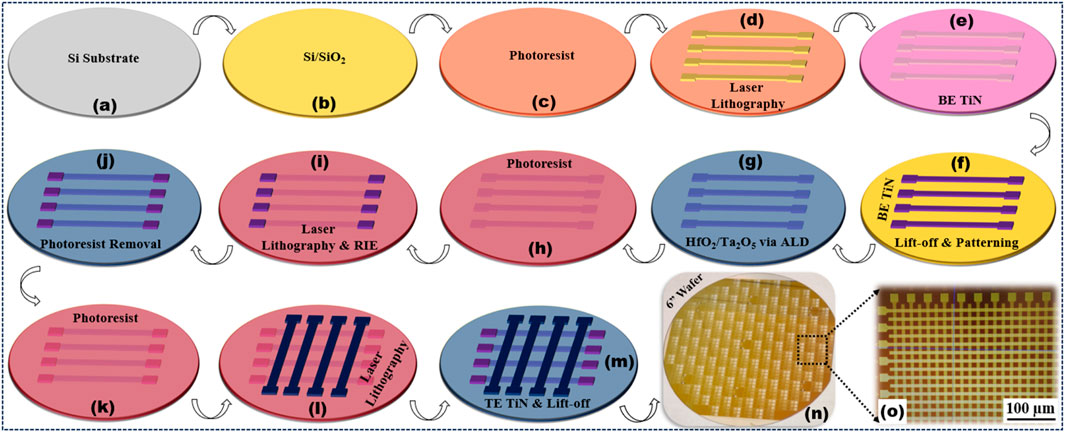
Figure 1. Step-by-step fabrication process for memristive devices on wafer scale; (a) Si substrate, (b) Thermally grown thick SiO2 layer (200 nm), (c) Photoresist spin-coating, (d) Laser lithography and development process, (e) Deposition of TiN BE via sputtering, (f) Lift-off process, (g) Deposition of thin HfO2 and Ta2O5 via thermal ALD, (h) Photoresist spin coating, (i) Laser lithography, development process and pad opening for BE through RIE, (j) Photoresist removal process, (k) Photoresist spin-coating, (l) Laser lithography and development process, (m) Deposition of TiN TE via sputtering and lift-off process, (n) Final wafer scale fabricated memristive crossbar array devices, and (o) Optical microscope images of fabricated memristive devices in array configuration.
The substrate undergoes thorough cleaning in an ultrasonicator with acetone and isopropanol (IPA) for 10 min each to remove surface impurities, such as dust particles and organic residues. To pattern the bottom electrode (BE), direct-write photolithography is performed using a MicroWriter ML® 3 Pro system (Durham Magneto Optics, DMO), followed by sputtering of a 50 nm TiN layer at room temperature, as shown in Figures 1c–f. The photolithography process utilizes a 5 µm resolution lens, a 405 nm light source, and a pre-optimized exposure dose of 180 mJ/cm2 to accurately define all three levels of the mask design. Next, ∼8 nm HfO2 and ∼2 nm Ta2O5 layers are deposited as a switching oxide layer without breaking vacuum, as illustrated in Figure 1g. The deposition temperature for both materials is maintained at 300°C. HfO2 is deposited using tetrakis (dimethylamido) hafnium (IV) (TDMAHf) as the hafnium precursor and H2O as the co-reactant, requiring nearly 78 ALD cycles. For Ta2O5, pentakis (dimethylamido) tantalum (PDMATa) serves as the tantalum precursor with H2O as the co-reactant, necessitating around 25 ALD cycles to achieve a ∼2 nm thickness.
The precursor bottles are heated to 75°C for TDMAHf and 105°C for PDMATa. Each HfO2 ALD cycle involves a 0.25 s TDMAHf pulse followed by a 5 s Ar purge, and a 0.06 s H2O pulse followed by another 5 s Ar purge, resulting in an average growth per cycle (GPC) of 0.1028 nm. For Ta2O5 deposition, each ALD cycle consists of a 0.6 s PDMATa pulse, a 5 s Ar purge, a 0.06 s H2O pulse, and a final 5 s Ar purge, achieving an average GPC of 0.0842 nm. After depositing the oxide layers, reactive ion etching (RIE) with CHF3/Ar plasma is used to expose the contact pads for the BEs. The etching duration is approximately 13 min to etch the HfO2/Ta2O5 bilayer, with an etch rate of 0.820 nm/min (Figures 1h–j). Finally, photolithography is performed to pattern the 50 nm top TiN electrode (TE) (Figures 1k–m). Figures 1n, o and (o) illustrate the optical microscope images of the final device on a large-area wafer scale having a device structure of TiN/HfO2/Ta2O5/TiN. The memory cell size in the fabricated arrays is (10 × 10) µm2.
3 Results and discussion
We utilize a custom in-house memristor testing tool (ArC ONE) for conducting these electrical measurements. Figure 2 illustrates the primary resistive switching mechanism observed in the fabricated bilayer memristive devices. The conduction process in these bilayer structures is primarily linked to the formation of conductive paths composed of oxygen vacancies (Ryu et al., 2021). Figure 2a shows the pristine device state in which there is no electric potential applied over the device. Typically, oxygen vacancies in resistive switching oxides are generated during the electroforming process, as shown in Figures 2b, c. The creation of conductive filaments during this initial forming stage can be explained by the migration of oxygen vacancies or ions from the TE toward the BE. Figure 2d shows the electroforming process during current-voltage (I-V) measurements wherein forming voltage (VF) is +5.5 V. Here, it should be noted that the initial resistance of the pristine device is in the range of 10–20 GΩ and after the forming event the device resistance is in the range of 5–7 kΩ.
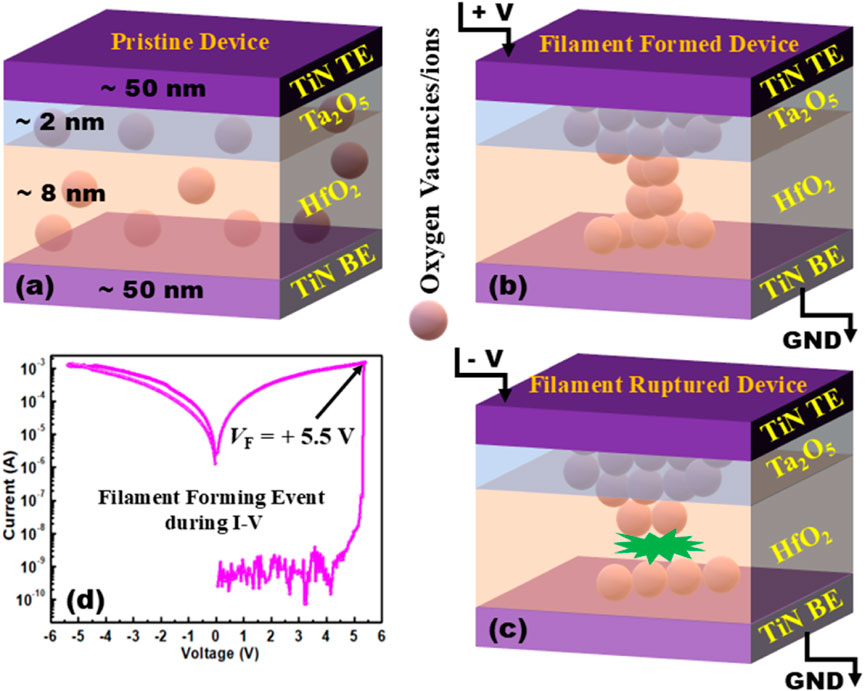
Figure 2. Dominant resistive switching mechanism: (a) Pristine device i.e., no electrical potential applied, (b) Formation of conductive filament throughout the switching oxide layers under the application of external applied electrical potential, (c) Filament ruptured device under reverse electrical potential, and (d) Filament forming event during I-V response.
Additionally, the fabricated devices demonstrate analog resistive switching behavior (Kumar et al., 2022b). To prevent permanent damage during measurements, a compliance current (ICC) of 1 mA is applied to the device (Kumar et al., 2023). After the forming event, ±4.5 V is imposed over the TE of the fabricated devices while BE is kept at the ground.
As observed from Figure 3a, under the positive voltage from 0 to +4.5 V, the memristive device is switched from a high resistance state (HRS) to a low resistance state (LRS) at the voltage of +3.75 V (i.e., D1), and this event is termed as “SET” process. While, under the negative voltage bias from 0 to −4.5 V on TE, the device resistance state is switched back from LRS to HRS at the voltage of −4.01 V (i.e., D1), and this process is known as the “RESET” process. Figures 3a–5a(D1-D34) depict the analog-type resistive switching responses of the randomly selected memristive devices from the fabricated crossbar array architecture. As observed, these devices exhibit stable bipolar resistive switching characteristics with some variations in the device switching voltages (VSET and VRESET) as illustrated in Figures 5b, 6a, b, e, f. Figure 5b displays the average values of the first 10 switching cycles of VSET and VRESET of individual devices (D1-D34).
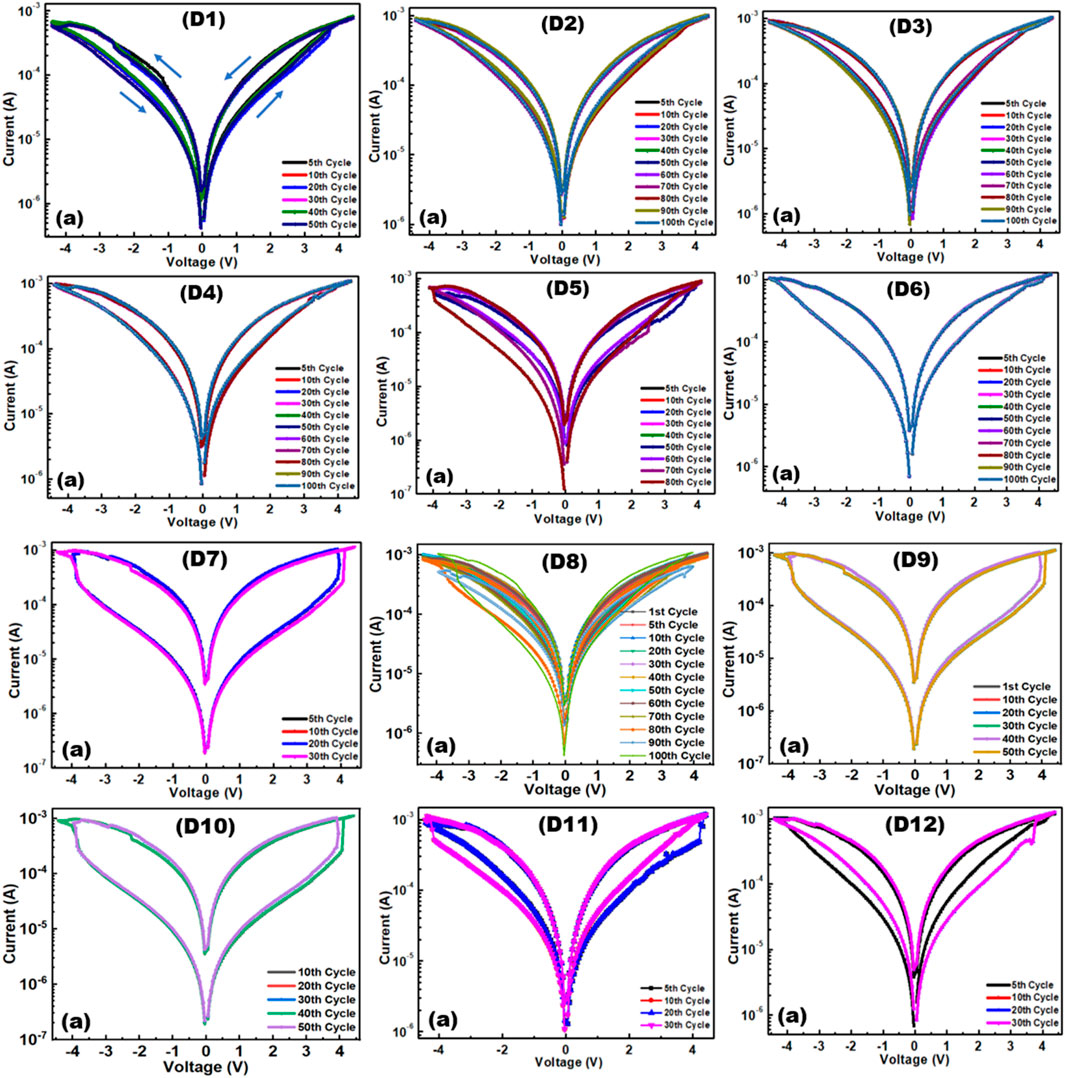
Figure 3. (a) Resistive switching responses of the randomly selected devices (D1-D12) from the fabricated memristive crossbar array structure.
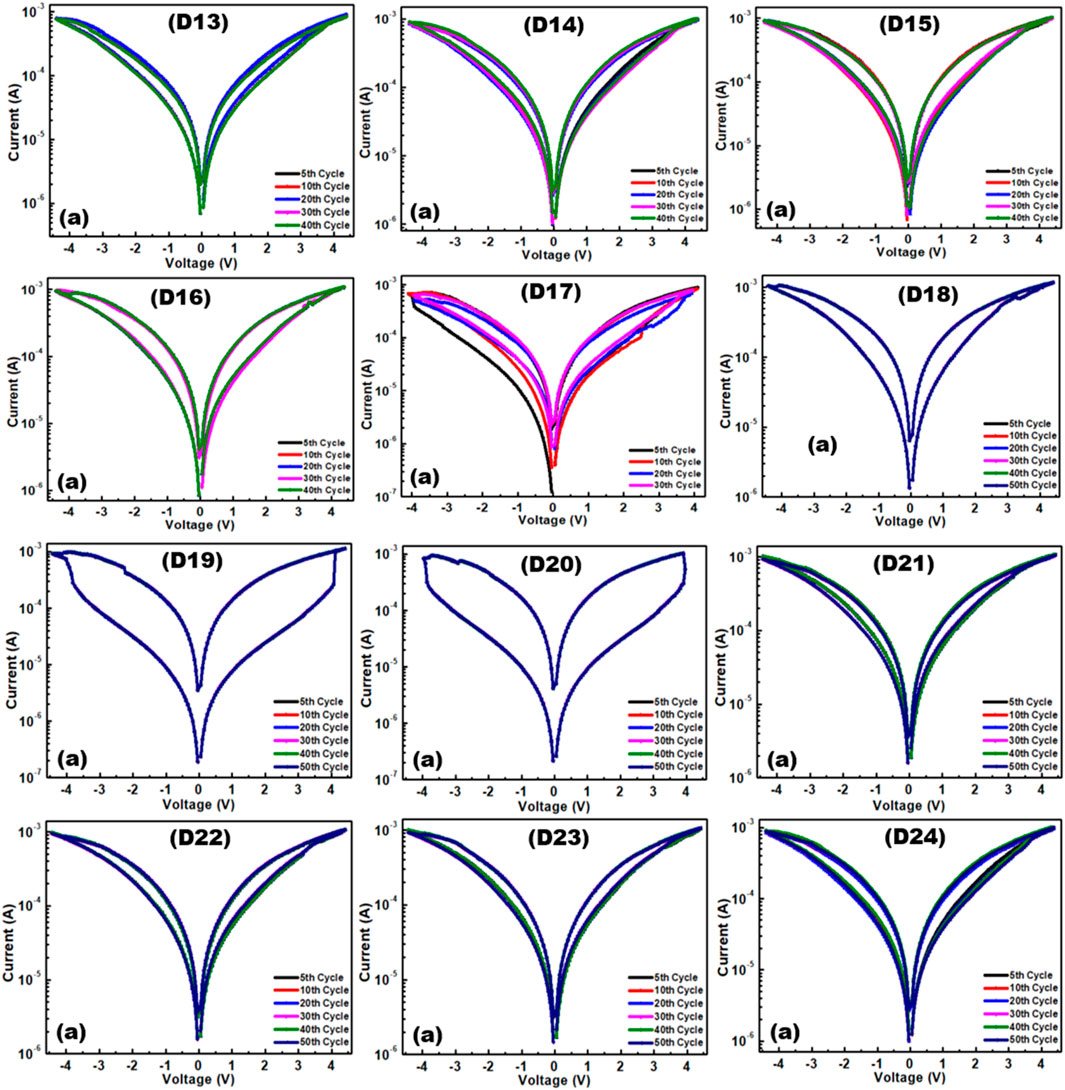
Figure 4. (a) Resistive switching responses of the randomly selected devices (D13-D24) from the fabricated memristive crossbar array structure.
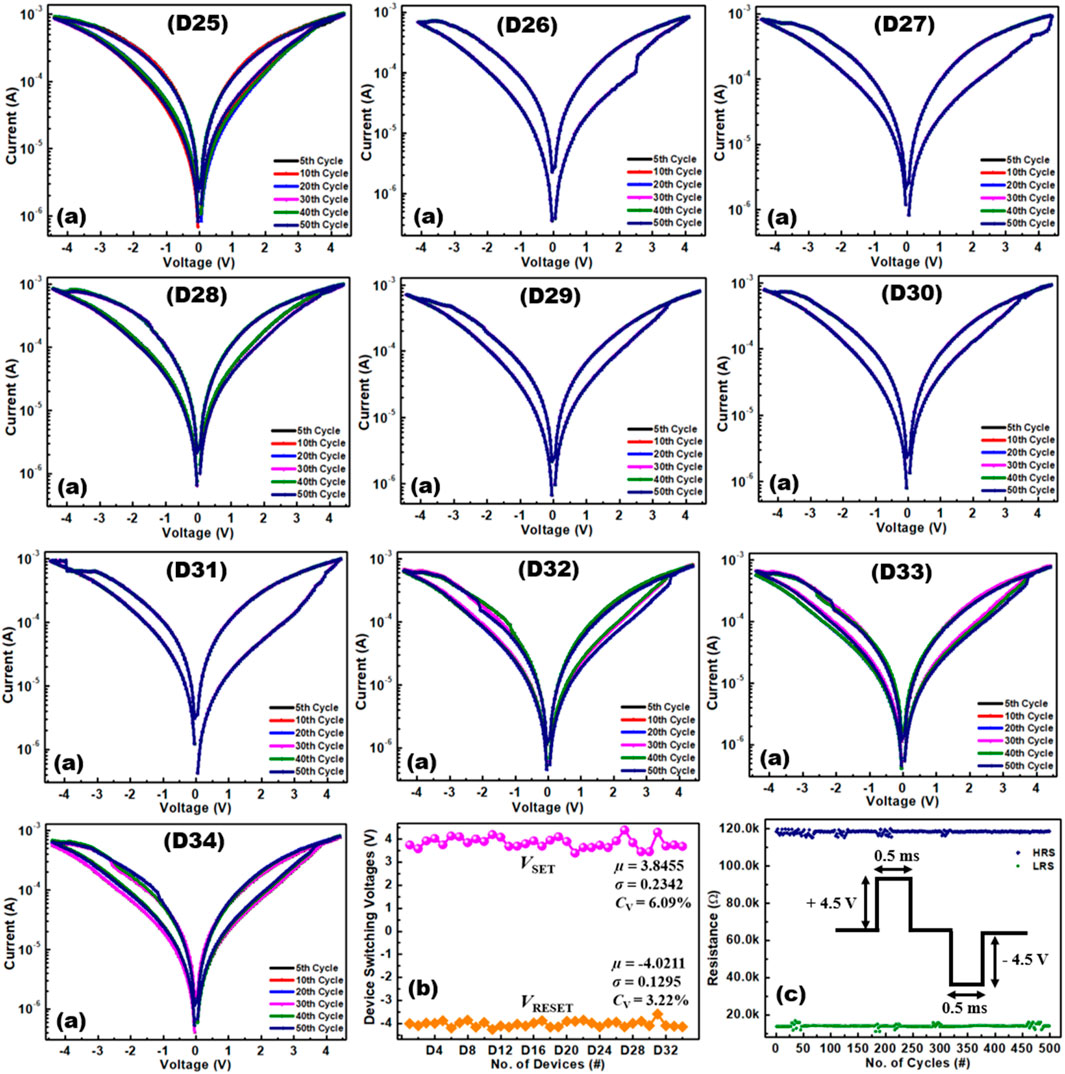
Figure 5. (a) Resistive switching responses of the randomly selected devices (D25-D36) from the fabricated memristive crossbar array structure, (b) D2D variations in VSET and VRESET, and (c) Pulse endurance tests up to consistent 500 cycles for device no. D31. Here, insets show the applied pulse scheme during the test.
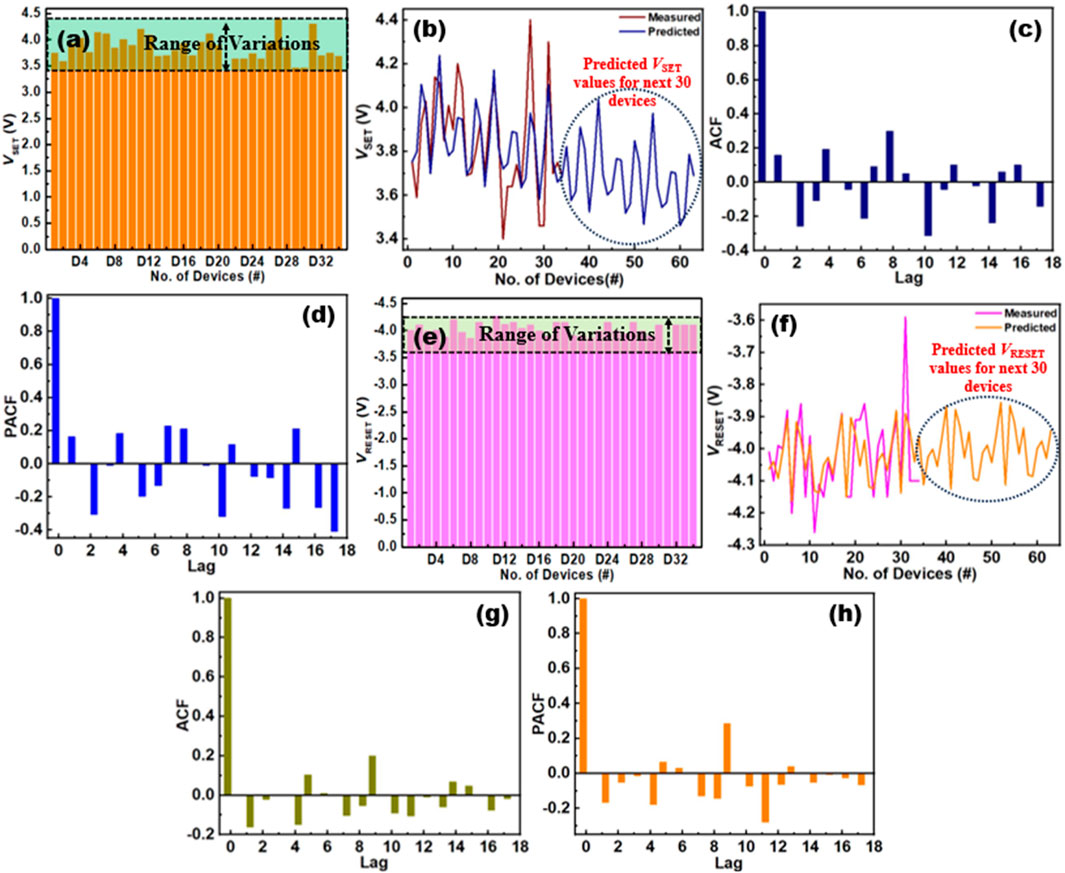
Figure 6. Variability analysis of randomly selected devices from wafer-scale memristive crossbar arrays: (a) VSET for (D1-D34), (b) Predicted values of VSET for next 30 devices corresponding to experimentally measured values, (c) Autocorrelation function of residual for VSET, (d) Partial autocorrelation function of residual for VSET, (e) VRESET for (D1-D34), (f) Predicted values of VRESET for next 30 devices corresponding to experimentally measured values, (g) Autocorrelation function of residual for VRESET, and (h) Partial autocorrelation function of residual for VRESET.
However, some observable variations have been seen which might have appeared due to the crossbar array configuration wherein sneak-path current is a serious concern (Shi et al., 2020; Chen et al., 2021). As discussed, the fabricated devices essentially required an electroforming process to obtain the switching responses. Therefore, non-uniform heat dissipation can cause localized hot spots. These variations can lead to either abrupt or gradual switching depending on the temperature dependence of the underlying mechanisms (Kumar et al., 2022c). Additionally, in memristive devices, switching involves the formation and rupture of conductive filaments (CFs) composed of defects including oxygen vacancies. The stochastic nature of CF formation leads to variability: abrupt switching occurs when a filament forms or breaks suddenly, while gradual switching results from partial or progressive filament changes. This inherent randomness contributes to inconsistencies in device behavior (Kumar et al., 2022c). Additionally, long endurance was also performed which further confirms the better device stability as shown in Figure 5c. However, each device has inherent variations (or uncontrolled ionic motion during the switching process) in the ON/OFF ratio, which might lead to the overall variation in the LRS and HRS values throughout the different devices over the wafer scale. Moreover, in the fabricated devices, a thin layer of Ta2O5 acts as the thermal enhanced layer to improve the uniformity of oxygen vacancy distribution during the switching process (Xiang et al., 2019; Wanga et al., 2021).
As analyzed in Figure 6, the randomly selected memristive devices show nearly 22.72% variations in the VSET concerning maximum VSET voltage as shown in Figure 6a while 15.72% variations in the VRESET concerning maximum VRESET voltage of the device as shown in Figure 6e. These observed variations cover a large area of the wafer as different locations of the device have been considered and electrically characterized to perform statistical analysis. Additionally, these variations are also correlated with the anomalies in the device fabrication process, material growth conditions, and quality of deposited thin films (Zheng et al., 2024; Li et al., 2021).
Moreover, time series analysis (TSA) techniques are utilized to model and forecast variations in the switching voltages, specifically VSET and VRESET. This statistical framework significantly helps to analyze collected data at regular intervals and predict the inherent patterns and trends in datasets (Roldan et al., 2021; Alonso et al., 2021; Roldan et al., 2023). This analytical methodology supports precise modeling, prediction, and forecasting and has been extensively applied across diverse research disciplines.
In recent years, the application of TSA to investigate and predict variations in switching parameters within resistive switching devices has garnered significant attention and exhibited substantial growth (Alonso et al., 2021; Thorat et al., 2024; Mullani et al., 2023). In this study, the analysis is focused on the VSET and VRESET series. Given the stoichiometric complexities and variability intrinsic to the switching parameters of memristive devices, addressing their nonlinear behavior necessitated the adoption of advanced TSA methodologies. To this end, the Holt-Winters Exponential Smoothing (HWES) technique is employed to model, predict, and forecast the data series as reported in (Rokade et al., 2024; Katkar et al., 2022).
The derived parameters α, β, and γ estimates are instrumental in constructing predictive models for VSET and VRESET. For VSET, the respective values are 1.4901 × 10−8, 1.4894 × 10−8, and 3.0798 × 10−15, while for VRESET, these are 1.49 × 10−8,1.489 × 10−8, and 6.1825 × 10−17. Utilizing these parameters, predictions for the switching voltages are generated, with the results illustrated in Figures 6b, f. Notably, the TSA approach proved highly effective in forecasting the switching voltages VSET and VRESET for the next 30 devices, as depicted in Figures 6b, f. These predictions closely aligned with the experimentally obtained values, thereby demonstrating the predictive accuracy of the HWES technique. The outcomes further reveal that the HWES method successfully captured variations in both switching voltages and current states. These findings validate the reliability of HWES in modelling the switching parameters of HfO2/Ta2O5-based devices. Furthermore, the autocorrelation function (ACF) and partial autocorrelation function (PACF) values of the residuals for all series, are presented in Figures 6c, d and Figures 6g–h, indicate an absence of significant lag in the residuals. This lack of correlation in both ACF and PACF confirms the robustness of the model (Rokade et al., 2024; Khot et al., 2024).
The realization of high-k dielectric metal oxide-based memristive devices faces a significant challenge in the fluctuations in device switching parameters during device-to-device (D2D) and cycle-to-cycle (C2C) (Kumar et al., 2022b; Baeumer et al., 2017; Sangwan et al., 2018). In the case of D2D, the variations are introduced due to inhomogeneity and anomalies in fabrication processes including nonuniformity and smoothness in the deposited thin films while C2C variations are dominated due to the stochastic nature of the resistive switching process (Sangwan et al., 2018). Therefore, to better analyze and quantify these fluctuations, the coefficient of variation (CV) plays a pivotal role which is defined as the ratio of the standard deviation (σ) to the mean (μ) (Chen et al., 2020; Kumar et al., 2022b). This crucial metric provides insights into the consistency and reliability of switching parameters.
In our study, device switching voltages (VSET and VRESET) of randomly selected devices are utilized and for C2C CV, a single memristive cell is considered. This approach allows us to gauge the extent of variability and enhance device performance evaluation. The cumulative distribution function (CDF) of VSET and VRESET in D2D and C2C are illustrated in Figures 7a–d which is calculated by using Equation 1 as follows for each value of VSET and VRESET.
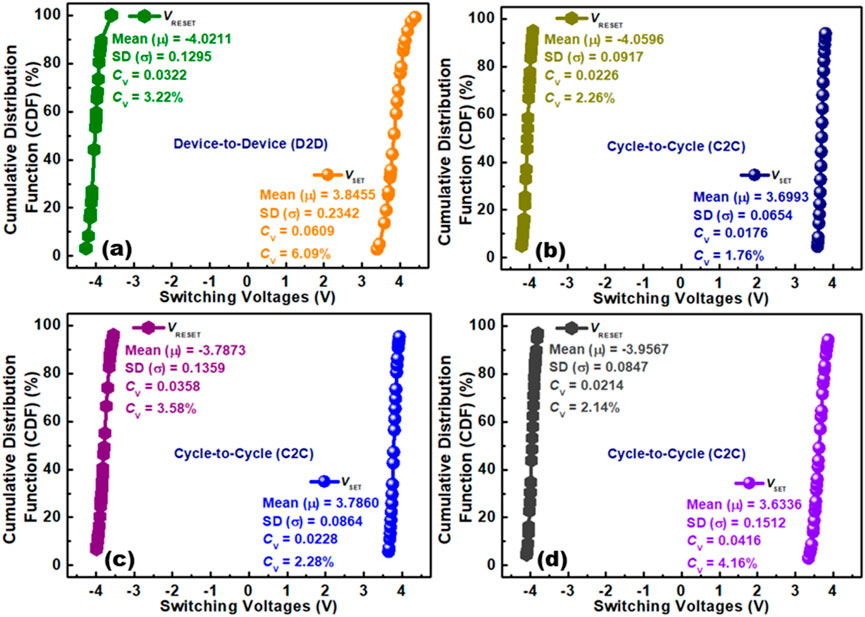
Figure 7. Variability analysis in terms of coefficient of variability (CV): (a) D2D, and (b-d) C2C in randomly selected memristive devices. Here, (b) D1, (c) D5, and (d) D8.
Here, µ is the mean, σ is the standard deviation, and x is the input value. To evaluate the values of D2D CV, randomly selected 34 devices and for C2C CV, 50 consistent cycles were utilized. As observed from Figure 7a, the values of D2D CV in VSET and VRESET are presented wherein VSET CV and VRESET CV are 6.09% and 3.22%, respectively. These lowest CV values in switching parameters are further associated with the thin film uniformity and low leakage current in the fabricated devices (Yun et al., 2021; Park et al., 2024). Figures 7b–d shows the values of C2C CV in multiple devices (D1, D5, and D8). Here, values of C2C CV are 1.76% (VSET), 2.26% (VRESET), 2.28% (VSET), 3.58% (VRESET), and 4.16% (VSET), and 2.14% (VRESET) associated with the device D1, D5 and D8, respectively. Moreover, these minimal values of CV validate the stability and reproducibility of the fabricated devices. Furthermore, the lower C2C variations ensure the reliability and stability consistency in memory cells across multiple read/write cycles. Additionally, low C2C variations support precise control over the resistance levels, which enables more accurate synaptic weight tuning in synaptic and neuromorphic computing tasks (Sun and Yu, 2019). The precise tunability of the synaptic weight in the biological synapses further enhances learning and recognition tasks.
The potentiation and depression functionality of the artificial synapse has been implemented by applying the input voltage pulses. Figure 8a shows the potentiation (P) process, wherein the device conductance is continuously strengthened under the application of a train of 50 positive successive pulses with VA = +4.0 V, PW = 100 µs, and PD = 10 µs In the case of the depression (D) process, the device conductance is continuously weakened under the application of a train of 50 negative pulses with VA = −4.0 V, PW = 100 µs, and PD = 10 µs Here, the amplitude of the read voltage pulse (VR) is ±0.5 V, as depicted in Figure 8c. Figure 8b depicts the combined plot of potentiation and depression which assists in evaluating the value of the nonlinearity (NL) factor for P and D processes and the calculated value to be 0.43 at pulse number (n) = 25. Here, to evaluate the value of the NL factor, Equation 2 formulation has been utilized (Kumar et al., 2022a; Wang et al., 2016):
where, GP(n) and GD(n) are the conductance values after the nth P-pulse and nth D-pulse, respectively. Here, it should be noted that the evaluated value of the NL factor is normalized with overall plasticity and defined in the range from 0 to 1 during a synaptic weight update sequence comprising an equal number (N) of consecutive P-pulses and D-pulses. However, for a completely linear synaptic weight update, the value of the NL factor is equal to 0 (Wang et al., 2016) wherein learning and forgetting processes can be overlapped. The obtained memristive device characteristics show a similar agreement with the P and D functionalities of the real biological synapse (Zhao et al., 2022). Moreover, paired-pulse facilitation (PPF) defines the pivotal information in short-term plasticity (STP) behavior (Santschi and Stanton, 2003), showing how the synaptic response of the first stimulus enhances the synaptic response to the second stimulus. In the biological synapses, PPF behavior is defined by the amplification of the second post-synaptic response current under the applications of two consecutive spike stimuli, where the interval between spikes is shorter than the recovery time (Zhang et al., 2017). Figure 8d shows the experimental characterization of PPF functionality in the fabricated devices which is calculated by utilizing Equation 3. This experimental evidence underscores the device’s capability to replicate crucial aspects of PPF behavior which is also observed in the biological synapses, showcasing its potential to emulate synaptic plasticity in neuromorphic computing (Tang et al., 2022).
here, A1, and A2 represent the amplitude of currents corresponding to the first and second voltage stimulus, respectively. In Figure 8d, the interrelation between the increase in rate and the amplitude of the synaptic response current during successive positive or negative pulses is illustrated for different time intervals. The pulse interval is systematically varied from 5 µs to 50 µs up to 200 µs, while maintaining a fixed pulse magnitude and width of 4 V and 10 µs, respectively. From Figure 8d, it is observed that under the consistently positive paired-pulse facilitation (PPF) across all pulse intervals, indicating that the current during the second pulse consistently exceeds that of the first pulse. In the case of paired-pulse depression (PPD), the current in the second pulse consistently decreases behind that of the first pulse as depicted in Figure 8e. Therefore, this electrical investigation provides in-depth insights into the dynamic behavior of the device, and its ability to replicate PPF and PPD mechanisms as similarly observed in the real biological synapses while varying pulse intervals. Finally, Table 1 shows a detailed comparison analysis between our work and other reported literature (Ghenzi et al., 2024; Ryu et al., 2021; Napari et al., 2024; Kumar et al., 2025; Kim et al., 2018).
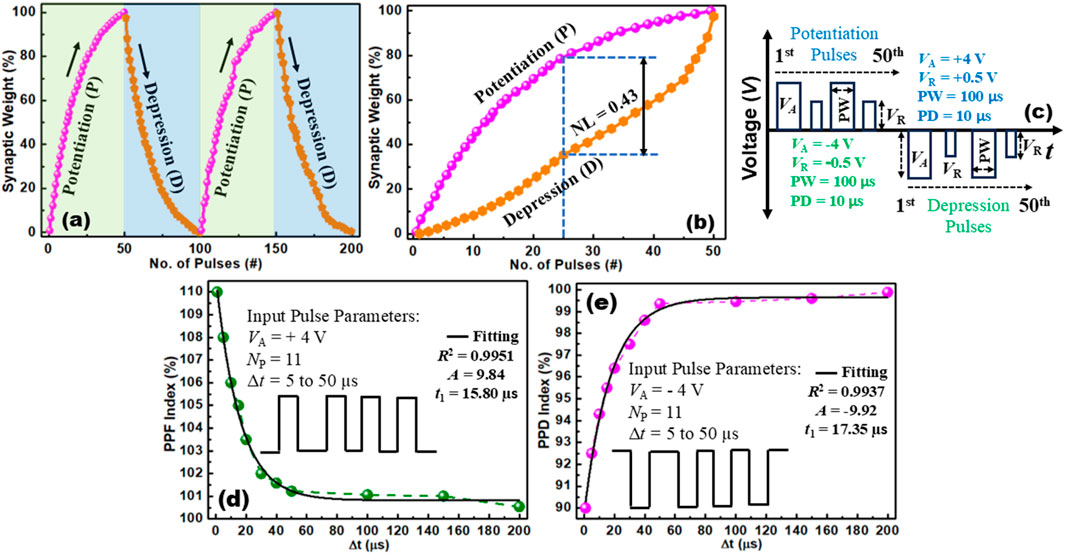
Figure 8. (a) Synaptic learning and forgetting responses in terms of potentiation and depression mechanisms under a train of the symmetric pulsing scheme, (b) Illustration of non-linearity factor analysis, and (c) Schematic representation of applied symmetric pulsing scheme during the weight update process. Here, PW is pulse width and PD is pulse delay, (d) Paired-pulse facilitation (PPF) index, and (e) Paired-pulse depression (PPD) index mechanisms. Insets show input pulsing schemes.
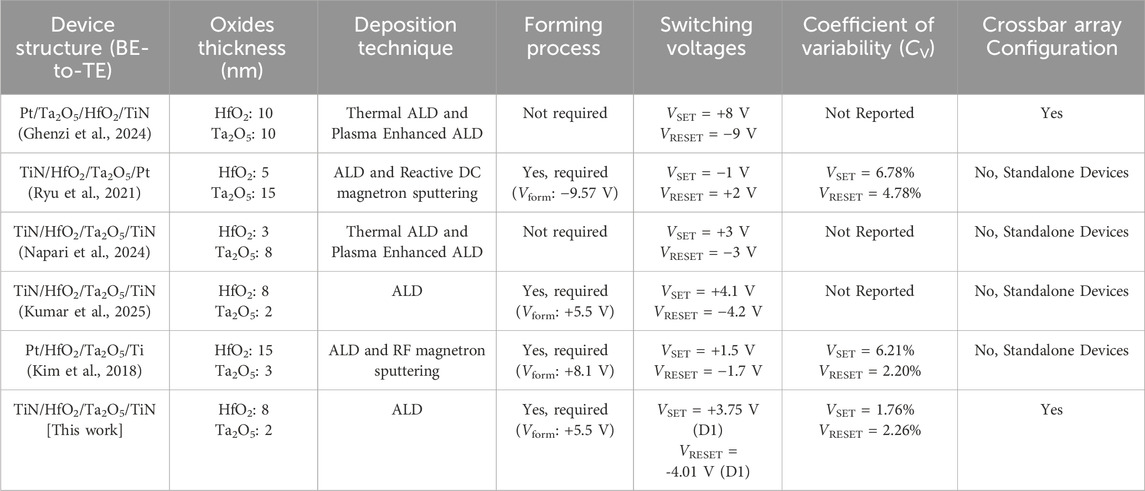
Table 1. Comparison analysis between this work and other reported work (Ghenzi et al., 2024; Ryu et al., 2021; Napari et al., 2024; Kumar et al., 2025; Kim et al., 2018).
4 Conclusion
Herein, we have reported the microfabrication process and in-depth electrical characterizations of the bilayer (HfO2/Ta2O5) memristive devices. A low-temperature single thermal ALD tool is utilized to deposit both active oxide layers at 300°C without breaking the system vacuum to minimize the effect of surface anomalies. The fabricated memristive devices required an electroforming process to show the stable bipolar resistive switching responses. The obtained outcomes suggest that all devices depict stable switching responses over hundreds of cycles. The randomly selected devices from wafer-scale memristive arrays exhibited 22.75% (VSET) and 15.72% (VRESET) variations in the device switching voltages corresponding to the maximum switching voltage of the tested devices. Additionally, the adopted TSA analysis efficiently predicted the device switching voltages (VSET and VRESET) for the next 30 devices which was well matched with the obtained experimental data. The values of coefficient of variability (CV) for D2D (CV: 3.22%) and C2C (CV: 1.76%) revealed the remarkable stability and reproducibility of the fabricated devices and confirmed that the ALD-grown thin film has a smooth and uniform surface. Furthermore, the fabricated devices are efficiently able to mimic the synaptic functionalities including potentiation, depression, PPF, and PPD under low pulse width which makes them a perfect candidate for synaptic and neuromorphic devices. The value of the NL factor (0.43) is close to the ideal value which suggests that these device configurations can be useful for developing ideal synaptic systems.
Data availability statement
The original contributions presented in the study are included in the article/supplementary material, further inquiries can be directed to the corresponding authors.
Author contributions
SK: Conceptualization, Data curation, Formal Analysis, Visualization, Writing – original draft, Writing – review and editing, Investigation, Methodology, Validation. DY: Data curation, Formal Analysis, Visualization, Writing – review and editing, Investigation. SS: Formal Analysis, Methodology, Supervision, Visualization, Writing – review and editing. TP: Formal Analysis, Funding acquisition, Project administration, Resources, Supervision, Validation, Visualization, Writing – review and editing.
Funding
The author(s) declare that financial support was received for the research and/or publication of this article. This work was supported by the EPSRC FORTE Programme (Grant No. EP/R024642/2) and by the RAEng Chair in Emerging Technologies (Grant No. CiET1819/2/93). SK would like to thank the Department of Science and Technology (DST), New Delhi for the research grant via IFA23-ENG-375.
Conflict of interest
The authors declare that the research was conducted in the absence of any commercial or financial relationships that could be construed as a potential conflict of interest.
Correction note
A correction has been made to this article. Details can be found at: 10.3389/fnano.2025.1650174.
Generative AI statement
The author(s) declare that no Generative AI was used in the creation of this manuscript.
Publisher’s note
All claims expressed in this article are solely those of the authors and do not necessarily represent those of their affiliated organizations, or those of the publisher, the editors and the reviewers. Any product that may be evaluated in this article, or claim that may be made by its manufacturer, is not guaranteed or endorsed by the publisher.
References
Alonso, F. J., Maldonado, D., Aguilera, A. M., and Roldan, J. B. (2021). Memristor variability and stochastic physical properties modeling from a multivariate time series approach. Chaos, Solit. and Fractals 143 (110461), 110461–110467. doi:10.1016/j.chaos.2020.110461
Amirsoleimani, A., Alibart, F., Yon, V., Xu, J., Pazhouhandeh, M. R., Ecoffey, S., et al. (2020). In-memory vector-matrix multiplication in monolithic complementary metal-oxide-semiconductor-memristor integrated circuits: design choices, challenges, and perspectives. Adv. Intell. Syst. 2 (11). doi:10.1002/aisy.202000115
Baeumer, C., Valenta, R., Schmitz, C., Locatelli, A., Mentes, T. O., Rogers, S. P., et al. (2017). Subfilamentary networks cause cycle-to-cycle variability in memristive devices. ACS Nano 11 (7), 6921–6929. doi:10.1021/acsnano.7b02113
Chen, S., Mahmoodi, M. R., Shi, Y., Mahata, C., Yuan, B., Liang, X., et al. (2020). Wafer-scale integration of two-dimensional materials in high-density memristive crossbar arrays for artificial neural networks. Nat. Electron. 3, 638–645. doi:10.1038/s41928-020-00473-w
Chen, Y. C., Lin, C. C., and Chang, Y. F. (2021). Post-moore memory technology: sneak path current (SPC) phenomena on RRAM crossbar array and solutions. Micromachines 12 (1), 50. doi:10.3390/mi12010050
Choi, B. J., Torrezan, A. C., Strachan, J. P., Kotula, P. G., Lohn, A. J., Marinella, M. J., et al. (2016). High-speed and low-energy nitride memristors. Adv. Funct. Mat. 26 (29), 5290–5296. doi:10.1002/adfm.201600680
Furber, S. (2016). Large-scale neuromorphic computing systems. J. Neural Eng. 13 (5), 051001. doi:10.1088/1741-2560/13/5/051001
Ghenzi, N., Park, T. W., Kim, S. S., Kim, H. J., Jang, Y. H., Woo, K. S., et al. (2024). Heterogeneous reservoir computing in second-order Ta2O5/HfO2 memristors. Nanoscale Horiz. 9, 427–437. doi:10.1039/d3nh00493g
He, Z. Y., Wang, T. Y., Meng, J. L., Zhu, H., Ji, L., Sun, Q. Q., et al. (2021). CMOS back-end compatible memristors for in situ digital and neuromorphic computing applications. Mat. Horiz. 8 (12), 3345–3355. doi:10.1039/D1MH01257F
Jeong, D. S., Kim, K. M., Kim, S., Choi, B. J., and Hwang, C. S. (2016). Memristors for energy-efficient new computing paradigms. Adv. Electron. Mat. 2 (9). doi:10.1002/aelm.201600090
Katkar, P. K., Padalkar, N. S., Kumbhar, D. D., Patil, A. H., Sutar, S. S., Kadam, S. J., et al. (2022). Binder-Free synthesis of nanostructured amorphous cobalt phosphate for resistive memory and artificial synaptic device applications. ACS Appl. Electron. Mater. 4 (4), 1852–1863. doi:10.1021/acsaelm.2c00085
Khot, A. C., Pawar, P. S., Dongale, T. D., Nirmal, K. A., Sutar, S. S., Jayan, K. D., et al. (2024). Self-assembled vapor-transport-deposited SnS nanoflake-based memory devices with synaptic learning properties. Appl. Surf. Sci. 648 (158994), 158994–10. doi:10.1016/j.apsusc.2023.158994
Kim, H., Mahmoodi, M. R., Nili, H., and Strukov, D. B. (2021). 4K-memristor analog-grade passive crossbar circuit. Nat. Commun. 12 (5198), 5198. doi:10.1038/s41467-021-25455-0
Kim, S., Abbas, Y., Jeon, Y. R., Sokolov, A. S., Ku, B., and Choi, C. (2018). Engineering synaptic characteristics of TaOx/HfO2 bi-layered resistive switching device. Nanotechnology 29, 415204. doi:10.1088/1361-6528/aad64c
Kumar, S., Agarwal, A., and Mukherjee, S. (2022b). Electrical performance of large-area Y2O3 memristive crossbar array with ultralow C2C variability. IEEE Trans. Electron Devices 69 (7), 3660–3666. doi:10.1109/TED.2022.3172400
Kumar, S., Das, M., Htay, M. T., Sriram, S., and Mukherjee, S. (2022c). Electroforming-free Y2O3 memristive crossbar array with low variability. ACS Appl. Electron. Mater. 4 (6), 3080–3087. doi:10.1021/acsaelm.2c00472
Kumar, S., Gautam, M. K., Yadav, S., and Mukherjee, S. (2023). Memcapacitive to memristive transition in Al/Y2O3/GZO crossbar array. IEEE Trans. Electron Devices 70 (6), 3341–3346. doi:10.1109/TED.2023.3265622
Kumar, S., Kumbhar, D. D., Park, J. H., Kamat, R. K., Dongale, T. D., and Mukherjee, S. (2022a). Y2O3-Based crossbar array for analog and neuromorphic computation. IEEE Trans. Electron Devices 70 (2), 473–477. doi:10.1109/TED.2022.3227890
Kumar, S., Yadav, D., Ramesh, R., Stathopoulos, S., Tsiamis, A., and Prodromakis, T. (2025). Electrical analysis of atomic layer deposited thin HfO2 and HfO2/Ta2O5-based memristive devices. IEEE Trans. Electron Devices 72 (4), 1780–1787. doi:10.1109/TED.2025.3539256
Li, Y., Loh, L., Li, S., Chen, L., Li, B., Bosman, M., et al. (2021). Anomalous resistive switching in memristors based on two-dimensional palladium diselenide using heterophase grain boundaries. Nat. Electron. 4, 348–356. doi:10.1038/s41928-021-00573-1
Mehonic, A., Sebastian, A., Rajendran, B., Simeone, O., Vasilaki, E., and Kenyon, A. J. (2020). Memristors-from in-memory computing, deep learning acceleration, and spiking neural networks to the future of neuromorphic and bio-inspired computing. Adv. Intell. Syst. 2 (11). doi:10.1002/aisy.202000085
Mullani, N. B., Kumbhar, D. D., Lee, D. H., Kwon, M. J., Yeon Cho, S., Oh, N., et al. (2023). Surface modification of a titanium carbide MXene memristor to enhance memory window and low-power operation. Adv. Funct. Mater. 33 (26), 1–13. doi:10.1002/adfm.202300343
Napari, M., Stathopoulos, S., Prodromakis, T., and Simanjuntak, F. (2024). Forming-Free and non-linear resistive switching in bilayer HfOx/TaOx memory devices by interface-induced internal resistance. Electron. Mater. Lett. 20, 363–371. doi:10.1007/s13391-023-00481-w
Park, T. W., Moon, J., Shin, D. H., Kim, H. J., Kim, S. S., Cho, J. M., et al. (2024). Enhancing uniformity, read voltage margin, and retention in three-dimensional and self-rectifying vertical Pt/Ta2O5/Al2O3/TiN memristors. ACS Appl. Mat. Interfaces 16, 65046–65057. doi:10.1021/acsami.4c15598
Rokade, K. A., Kumbhar, D. D., Patil, S. L., Sutar, S. S., More, K. V., Dandge, P. B., et al. (2024). CogniFiber: harnessing biocompatible and biodegradable 1D collagen nanofibers for sustainable nonvolatile memory and synaptic learning applications. Adv. Mater. 36 (24), e2312484–13. doi:10.1002/adma.202312484
Roldan, J. B., Maldonado, D., Alonso, F. J., Roldan, A. M., Hui, F., Shi, Y., et al. (2021). “Time series modeling of the cycle-to-cycle variability in h-BN based memristors,” in 2021 IEEE International Reliability Physics Symposium (IRPS), Monterey, CA, USA, 21-25 March 2021, 1–5. doi:10.1109/IRPS46558.2021.9405100
Roldan, J. B., Miranda, E., Maldonado, D., Mikhaylov, A. N., Agudov, N. V., Dubkov, A. A., et al. (2023). Variability in resistive memories. Adv. Intell. Syst. 5 (6), 1–46. doi:10.1002/aisy.202200338
Ryu, J. H., Mahata, C., and Kim, S. (2021). Long-term and short-term plasticity of Ta2O5/HfO2 memristor for hardware neuromorphic application. J. Alloys Compd. 850, 156675. doi:10.1016/j.jallcom.2020.156675
Sangwan, V. K., Lee, H. S., Bergeron, H., Balla, I., Beak, M. E., Chen, K. S., et al. (2018). Multi-terminal memtransistors from polycrystalline monolayer molybdenum disulfide. Nature 554, 500–504. doi:10.1038/nature25747
Santschi, L. A., and Stanton, P. K. (2003). A paired-pulse facilitation analysis of long-term synaptic depression at excitatory synapses in rat hippocampal CA1 and CA3 regions. Brain Res. 962 (1-2), 78–91. doi:10.1016/S0006-8993(02)03846-5
Shi, L., Zheng, G., Tian, B., Dkhil, B., and Duan, C. (2020). Research progress on solutions to the sneak path issue in memristor crossbar arrays. Nanoscale Adv. 2, 1811–1827. doi:10.1039/D0NA00100G
Singh, A., Choi, S., Wang, G., Daimari, M., and Lee, B. G. (2025). Analysis and fully memristor-based reservoir computing for temporal data classification. Neural Netw. 182, 106925. doi:10.1016/j.neunet.2024.106925
Sun, X., and Yu, S. (2019). Impact of non-ideal characteristics of resistive synaptic devices on implementing convolutional neural networks. IEEE J. Emerg. Sel. Top. Circuits Syst. 9 (3), 570–579. doi:10.1109/JETCAS.2019.2933148
Tang, X., Yang, L., Huang, J., Chen, W., Li, B., Yang, S., et al. (2022). Controlling sulfurization of 2D Mo2C crystal for Mo2C/MoS2-based memristor and artificial synapse. npj Flex. Electron. 6 (93), 93. doi:10.1038/s41528-022-00227-y
Thorat, P. S., Kumbhar, D. D., Oval, R., Kumar, S., Awale, M., Ramanathan, T. V., et al. (2024). On the time series analysis of resistive switching devices. Microelectron. Eng. 297, 112306. doi:10.1016/j.mee.2024.112306
Torrezan, A. C., Strachan, J. P., Ribeiro, G. M., and Williams, R. S. (2011). Sub-nanosecond switching of a tantalum oxide memristor. Nanotechnology 22 (48), 1–7. doi:10.1088/0957-4484/22/48/485203
Wang, I.-T., Chang, C.-C., Chiu, L.-W., Chou, T., and Hou, T.-H. (2016). 3D Ta/TaOx/TiO2/Ti synaptic array and linearity tuning of weight update for hardware neural network applications. Nanotechnology 27 (36), 365204. doi:10.1088/0957-4484/27/36/365204
Wanga, J., Zhuge, X., and Zhuge, F. (2021). Hybrid oxide brain-inspired neuromorphic devices for hardware implementation of artificial intelligence. Sci. Technol. Adv. Mater. 22 (1), 326–344. doi:10.1080/14686996.2021.1911277
Xia, Q., and Yang, J. J. (2019). Memristive crossbar arrays for brain-inspired computing. Nat. Mat. 8, 309–323. doi:10.1038/s41563-019-0291-x
Xiang, Y., Huang, P., Zhao, Y., Zhao, M., Gao, B., Wu, H., et al. (2019). Impacts of state instability and retention failure of filamentary analog RRAM on the performance of deep neural network. IEEE Trans. Electron Devices 66 (11), 4517–4522. doi:10.1109/TED.2019.2931135
Yun, C., Webb, M., Li, W., Wu, R., Xiao, M., Hellenbrand, M., et al. (2021). High performance, electroforming-free, thin film memristors using ionic Na0.5Bi0.5TiO3. J. Mat. Chem. C 9, 4522–4531. doi:10.1039/D1TC00202C
Zhang, X., Liu, S., Zhao, X., Wu, F., Wu, Q., Wang, W., et al. (2017). Emulating short-term and long-term plasticity of bio-synapse based on Cu/a-Si/Pt memristor. IEEE Electron Device Lett. 38 (9), 1208–1211. doi:10.1109/LED.2017.2722463
Zhang, Y., Wang, Z., Zhu, J., Yang, Y., Rao, M., Song, W., et al. (2019). Brain-inspired computing with memristors: challenges in devices, circuits, and systems. Appl. Phys. Rev. 7 (1). doi:10.1063/1.5124027
Zhao, M., Sun, Y., Yan, L., Zhao, Z., Wang, L., Yan, X., et al. (2022). Memristor with BiVO4 nanoparticle as artificial synapse for neuroinspired computing. Appl. Phys. Lett. 120 (9), 093501. doi:10.1063/5.0079418
Zheng, H., Li, L., Chien, Y. C., Yang, J., Li, S., Jain, S., et al. (2024). Memristor array based on wafer-scale 2D HfS2 for dual-mode physically unclonable functions. ACS Appl. Mater. and Interfaces 16 (47), 64963–64975. doi:10.1021/acsami.4c11340
Keywords: memristive devices, oxide materials, performance matrix, atomic layer deposition, variability factor, device stability
Citation: Kumar S, Yadav D, Stathopoulos S and Prodromakis T (2025) Performance and variability analysis of ALD-grown wafer scale HfO2/Ta2O5-based memristive devices for neuromorphic computing. Front. Nanotechnol. 7:1621554. doi: 10.3389/fnano.2025.1621554
Received: 02 May 2025; Accepted: 10 June 2025;
Published: 19 June 2025; Corrected: 26 June 2025.
Edited by:
Carlo Ricciardi, Polytechnic University of Turin, ItalyReviewed by:
Itir Koymen, TOBB University of Economics and Technology, TürkiyeMaria Elias Pereira, Instituto de Desenvolvimento de Novas Tecnologias (UNINOVA), Portugal
Copyright © 2025 Kumar, Yadav, Stathopoulos and Prodromakis. This is an open-access article distributed under the terms of the Creative Commons Attribution License (CC BY). The use, distribution or reproduction in other forums is permitted, provided the original author(s) and the copyright owner(s) are credited and that the original publication in this journal is cited, in accordance with accepted academic practice. No use, distribution or reproduction is permitted which does not comply with these terms.
*Correspondence: Sanjay Kumar, c2FuamF5c2loYWc5MUBnbWFpbC5jb20=; Themis Prodromakis, dC5wcm9kcm9tYWtpc0BlZC5hYy51aw==
 Sanjay Kumar
Sanjay Kumar Deepika Yadav1
Deepika Yadav1 Themis Prodromakis
Themis Prodromakis